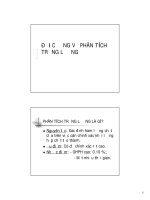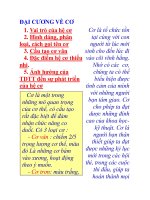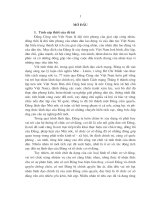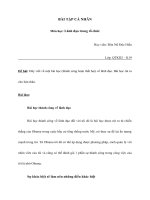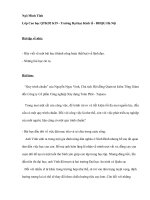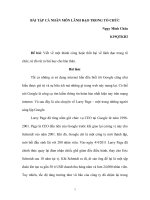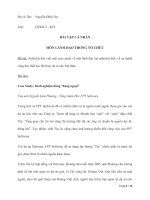Đại cương về lãnh đạo trong tổ chức chapter 8 team leadership
Bạn đang xem bản rút gọn của tài liệu. Xem và tải ngay bản đầy đủ của tài liệu tại đây (792.56 KB, 33 trang )
.c
om
co
ng
Chapter 8
cu
u
du
o
ng
th
an
Team Leadership
and
Self-Managed Teams
Copyright © 2010 by South-Western/Cengage Learning
All rights reserved.
CuuDuongThanCong.com
PowerPoint Presentation by Rhonda S. Palladi
Georgia State University
/>
.c
om
The Use of Teams in
Organizations
an
co
ng
Is a way of life in postmodern organizations
For many organizations, the use of teams has
led to desirable performance improvements,
such as:
ng
th
Improved quality, efficiency, employee satisfaction,
and customer satisfaction
cu
u
du
o
For some organizations, however, the use of
teams has resulted in negative outcomes, such
as:
Increased costs, stress, and lower group cohesion
2
CuuDuongThanCong.com
/>
ng
du
o
u
cu
th
an
CuuDuongThanCong.com
ng
TEAM
Have a sense of shared mission
Have collective responsibility
Focus on sharing information,
insights, and perspectives
Make decisions that support
each individual to do his or her
own job better
Reinforce each other’s
individual performance
standards
Have a participative or
empowerment-oriented
leadership style
Have performance measures
that create direct
accountability for the team
Strive for equality between
3
members
co
GROUP
Focus on individual
performance and goals
Rely on individual abilities
Work more independently with
greater motivation to achieve
personal goals
Have a very hierarchical
leadership style
Characterized by individual
self-interest
.c
om
Groups vs. Teams:
What is the Difference?
/>
co
an
th
DISADVANTAGES
Pressure to conform to
group standards of
performance and
conduct
Resistance to the team
effort from impinging
on autonomy
Social loafing
Groupthink
Intergroup conflicts
High levels of pressure
and stress
ng
ng
du
o
u
cu
ADVANTAGES
Synergy
Avoidance of major
errors
Faster, better decisions
Continuous
improvement
Innovation
Self-motivation
Empowerment
Greater job satisfaction
Needs fulfillment
.c
om
Advantages and Disadvantages
of Teamwork
4
CuuDuongThanCong.com
/>
.c
om
Social Loafing
cu
u
du
o
ng
th
an
co
ng
Is the conscious or unconscious tendency
by some team members to shirk
responsibilities by withholding effort
toward group goals when they are not
individually accountable for their work
Is likely when individual effort is not
recognized and assessed
Individual-level performance appraisal
helps reduce social loafing, but risks
jeopardizing team interaction and
synergy
5
CuuDuongThanCong.com
/>
.c
om
Groupthink
cu
u
du
o
ng
th
an
co
ng
Is when members of a cohesive group tend to
agree on a decision not on the basis of its merit
but because they are less willing to risk rejection
for questioning a majority viewpoint or
presenting a dissenting opinion
Unanimity is more important than objectivity
Dissenting views are suppressed in favor of
consensus
Can be remedied by training team members to
become effective participants in the decisionmaking process
6
CuuDuongThanCong.com
/>
.c
om
Components of Team Effectiveness
Task performance
th
Group process
an
co
ng
Is the degree to which the team’s output
meets the needs and expectations of those
who use it
u
du
o
ng
Is the degree to which members interact or
relate that allow the team to work
increasingly well together over time
cu
Individual satisfaction
Is the degree to which the group
experience, on balance, is more satisfying
than frustrating to team members
CuuDuongThanCong.com
/>
7
u
du
o
ng
th
an
co
ng
Team norms
Team leadership
Team cohesiveness and interdependence
Team composition
Team structure
Organizational support
Team creativity
cu
.c
om
Characteristics of Effective Teams
8
CuuDuongThanCong.com
/>
.c
om
Team Norms
cu
u
du
o
ng
th
an
co
ng
Are acceptable standards of behavior
shared by team members
Influence how members perceive and
interact with one another, approach
decisions, and solve problems
Begin developing and being accepted at
the early stages of team formation
9
CuuDuongThanCong.com
/>
Effective team leaders:
.c
om
Team Leadership
cu
u
du
o
ng
th
an
co
ng
Must recognize that not everyone knows how to be a
team player
Must display self-sacrificing behavior and selfconfidence
Employ multiple influencing tactics to control and
direct team member action toward the achievement of
organizational goals
Encourage norms that positively affect the team’s
goals and alter those that are negative
Observe with a keen eye what’s going on in the team
Must be adaptive, knowing when to play different
roles
10
CuuDuongThanCong.com
/>
.c
om
Team Cohesiveness
and Interdependence
co
ng
Team cohesion is the extent to which team
members band together and remain committed
to achieving team goals
cu
u
du
o
ng
th
an
Team cohesion is increased when:
Team members agree on common purpose and
direction
External parties give high praise and recognition for
the team’s success
The organization encourages and motivates teams to
compete with each other for rewards
Members find they have common ground and similar
attitudes and values
Members enjoy being on the team
11
CuuDuongThanCong.com
/>
.c
om
Team Composition
co
ng
Focuses on the diversity in knowledge,
background, and experiences of team
members
cu
u
du
o
ng
th
an
Team diversity reduces the likelihood of
groupthink
Teams that do not manage diversity well may
suffer negative consequences
Good working relationships require good social
skills for team members
Size also impacts team effectiveness
Small teams of under 12 members are
generally more effective
CuuDuongThanCong.com
/>
12
.c
om
Organizational Support
cu
u
du
o
ng
th
an
co
ng
Effective teams have strong support from
top management
Assessing team effectiveness as part of
overall organizational performance is an
important role of top management
13
CuuDuongThanCong.com
/>
.c
om
Team Creativity
cu
u
du
o
ng
th
an
co
ng
Is the creation of a valuable, useful, and
novel product, service, idea, procedure,
or process carried out via discovery
rather than a predetermined step-bystep procedure, by individuals working
together in a complex social system
Organizations that will survive and thrive
are those that make the best use of the
creativity of their workforce
14
CuuDuongThanCong.com
/>
.c
om
Organizational Practices that
Foster Team Creativity
co
ng
Provide
adequate
and quality
resources
Provide
appropriate
recognition
and
rewards
u
cu
Provide
supportive
climate
and
culture
du
o
ng
th
an
Organizational
Practices that
Foster
Team Creativity
Provide
flexibility
and a minimum
amount of
structure
15
CuuDuongThanCong.com
/>
.c
om
Team Leader Practices
that Foster Creativity
th
an
Giving team members greater
autonomy to do the job
Protecting against
“creativity blockers”
cu
u
du
o
ng
Team Leader
Practices
that
Foster
Creativity
co
ng
Matching people with the
right assignments
Ensuring the availability of
adequate time, money, and
other resources
16
CuuDuongThanCong.com
/>
.c
om
Types of Teams
du
o
ng
th
an
Cross-Functional Team
Virtual Team
cu
u
Types
of
Teams
co
ng
Functional Team
Self-Managed Team
17
CuuDuongThanCong.com
/>
.c
om
Functional Team
cu
u
du
o
ng
th
an
co
ng
Is a group of employees belonging to the same
functional department, such as marketing, R&D,
who have a common objective
Hierarchical structure with the functional leader
making all the decisions
Team members tend to focus on their local area
of specialization ignoring the overall
organizational mission
There is no one best leadership style to use
The use of functional structure has been in
decline
18
CuuDuongThanCong.com
/>
.c
om
Cross-Functional Team
cu
u
du
o
ng
th
an
co
ng
Is made up of members of different functional
departments of an organization who are brought
together to perform unique tasks to create new
and nonroutine products or services
Some members may be from outside the
organization
Interaction, cooperation, coordination,
information sharing, and cross-fertilization of
ideas among people from different functional
areas produces better quality products/services
with shorter development cycles
19
CuuDuongThanCong.com
/>
.c
om
Virtual Team
cu
u
du
o
ng
th
an
co
ng
Is one whose members are
geographically distributed, requiring
them to work together through electronic
means with minimal face-to-face
interaction
New and advanced technologies are
providing the means for teamwork that
is dispersed (carried out in different
locations) and asynchronous (carried out
at different times)
20
CuuDuongThanCong.com
/>
.c
om
Self-Managed Team (SMT)
cu
u
du
o
ng
th
an
co
ng
Are relatively autonomous teams whose
members share or rotate leadership
responsibilities and hold themselves mutually
responsible for a set of performance goals
assigned by higher management
Are usually cross-functional in membership
makeup
Have wide latitude in decision making
Can manage themselves, plan and schedule
work, and take action on problems
21
CuuDuongThanCong.com
/>
.c
om
Leader-Centered
Decision-Making Model
u
du
o
ng
th
an
Focus on task
Ignore personal feelings and relationships
Seek opinions
Get agreement
Make final decisions
Stay in control
Stop disruptions
Discourage members from expressing their feelings
Keep it rational
Guard against threats to his or her authority
cu
co
ng
The leader exercises his or her power to initiate,
direct, drive, instruct, and control team members
To be successful, the leader should:
CuuDuongThanCong.com
/>
22
.c
om
Team-Centered
Decision-Making Model
co
ng
Feelings
Needs
Interactions
Conflict
du
o
–
–
–
–
th
an
Listen attentively
Watch for nonverbal cues
Be aware of members’:
ng
Empowers team members to make decisions and follow
through
To be successful, the team leader should:
cu
u
Serve as a consultant, advisor, teacher, and facilitator
Model appropriate leadership behaviors
Establish a climate of approval for expression of feelings and
ideas
Relinquish control to the team
Allow the team to make final decisions
CuuDuongThanCong.com
/>
23
.c
om
Team-Centered DecisionMaking Model (cont.)
Advantages
cu
u
du
o
ng
th
an
co
ng
Can improve decision quality
Shifts much of the decision making away
from the leader
Allows the leader to think more strategically
Allows responsibility to be diffused among
several people
Results in higher commitment by team
members to implement decisions as
compared to decisions made alone by a
leader
24
CuuDuongThanCong.com
/>
.c
om
Team-Centered DecisionMaking Model (cont.)
Disadvantages
cu
u
du
o
ng
th
an
co
ng
Can take longer than decisions made alone
by a manager
Can be self-serving and contrary to the best
interests of the organization, if team
members have objectives and/or priorities
different from those of the leader
Can end up being a poor compromise rather
than an optimal solution
25
CuuDuongThanCong.com
/>
